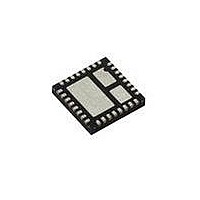SIC417CD-T1-E3 Vishay, SIC417CD-T1-E3 Datasheet - Page 9

SIC417CD-T1-E3
Manufacturer Part Number
SIC417CD-T1-E3
Description
IC DRIVER MOSF SYNC BUCK 55MLPQ
Manufacturer
Vishay
Series
microBUCK™r
Datasheet
1.SIC417CD-T1-E3.pdf
(20 pages)
Specifications of SIC417CD-T1-E3
Topology
Step-Down (Buck) Synchronous (1), Linear (LDO) (1)
Function
Any Function
Number Of Outputs
2
Frequency - Switching
200kHz ~ 1MHz
Voltage/current - Output 1
0.5 V ~ 5.5 V, 10A
Voltage/current - Output 2
0.75 V ~ 5.25 V, 150mA
W/led Driver
No
W/supervisor
No
W/sequencer
No
Voltage - Supply
3 V ~ 28 V
Operating Temperature
-25°C ~ 125°C
Mounting Type
*
Package / Case
*
Output Voltage
0.5 V to 5.5 V
Output Current
10 A
Input Voltage
3 V to 28 V
Switching Frequency
200 KHz to 1 MHz
Mounting Style
SMD/SMT
Duty Cycle (max)
95 %
Primary Input Voltage
28V
No. Of Outputs
1
Voltage Regulator Case Style
MLPQ
No. Of Pins
32
Operating Temperature Range
-25°C To +125°C
Svhc
No SVHC
Rohs Compliant
Yes
Lead Free Status / RoHS Status
Lead free / RoHS Compliant
Lead Free Status / RoHS Status
Lead free / RoHS Compliant, Lead free / RoHS Compliant
Available stocks
Company
Part Number
Manufacturer
Quantity
Price
Part Number:
SIC417CD-T1-E3
Manufacturer:
VISHAY/威世
Quantity:
20 000
Ultrasonic Power-Save Operation
The SiC417 provides ultra-sonic power-save operation at
light loads, with the minimum operating frequency fixed at
25 kHz. This is accomplished using an internal timer that
monitors the time between consecutive high-side gate
pulses.
If the time exceeds 40 µs, DL drives high to turn the low-side
MOSFET on. This draws current from V
inductor, forcing both V
to the 500 mV threshold, the next DH on-time is triggered.
After the on-time is completed the high-side MOSFET is
turned off and the low-side MOSFET turns on, the low-side
MOSFET remains on until the inductor current ramps down
to zero, at which point the low-side MOSFET is turned off.
Document Number: 69062
S10-1367-Rev. D, 14-Jun-10
DH
DH
FB ripple
voltage (V
DL
DL
Inductor
current
Inductor
current
FB ripple
voltage (V
After the 40 µs time-out, DL drives high if V
has not reached the FB threshold.
Figure 4 - Forced Continuous Mode Operation
FB
Figure 5 - Ultrasonic power-save Operation
FB
)
)
DL drives high when on-time is completed.
DL remains high until V
minimum f
On-time
(t
On-time
(t
ON
ON
)
)
SW
OUT
~ 25 kHz
and V
DH on-time is triggered when
V
FB
FB
reaches the FB threshold
DH on-time is triggered when
V
falls to the FB threshold.
FB
FB
reaches the FB threshold
to fall. When V
FB
DC load current
OUT
FB threshold
FB threshold
(500 mV)
(500 mV)
through the
(0A)
FB
drops
Because the on-times are forced to occur at intervals no
greater than 40 µs, the frequency will not fall below ~ 25 kHz.
Figure 5 shows ultra-sonic power-save operation.
Benefits of Ultrasonic Power-Save
Having a fixed minimum frequency in power-save has some
significant advantages as below:
• The minimum frequency of 25 kHz is outside the audible
• The output voltage ripple seen in power-save mode is
• Lower ripple in power-save also makes the power
Figure 6 shows the behavior under power-save and
continuous conduction mode at light loads.
Smart Power-Save Protection
Active loads may leak current from a higher voltage into the
switcher output. Under light load conditions with power-
savepower-save enabled, this can force V
and reach the over-voltage threshold, resulting in a hard
shutdown. Smart power-save prevents this condition.
When the FB voltage exceeds 10 % above nominal (exceeds
550 mV), the device immediately disables power-save, and
DL drives high to turn on the low-side MOSFET. This draws
current from V
fall. When V
t
This method prevents a hard OVP shutdown and also cycles
energy from V
power by avoiding forced conduction mode operation.
Figure 7 shows typical waveforms for the smart power-save
feature.
ON
range of human ear. This makes the operation of the
SiC417 very quiet.
significant lower than conventional power-save, which
improves efficiency at light loads.
component selection easier.
switching cycle begins.
Figure 6 - Ultrasonic Power-Save Operation Mode
FB
OUT
OUT
drops back to the 500 mV trip point, a normal
through the inductor and causes V
back to V
IN
. It also minimizes operating
Vishay Siliconix
OUT
www.vishay.com
SiC417
to slowly rise
OUT
to
9












